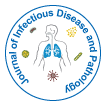Immune Response Mechanisms: The Body's Defense Against Infection
Received Date: Oct 01, 2024 / Published Date: Oct 30, 2024
Abstract
The immune system is a sophisticated network that protects the body from a wide range of pathogens, including bacteria, viruses, fungi, and parasites. This article explores the two main branches of the immune response: innate and adaptive immunity. Innate immunity serves as the first line of defense, utilizing physical barriers and immune cells to respond quickly to infections. In contrast, adaptive immunity provides a specific and long-lasting response, characterized by the activation of B and T lymphocytes, which produce antibodies and destroy infected cells. Key mechanisms of immune response include pathogen recognition, activation, effector functions, and the formation of immunological memory. Additionally, the regulation of the immune response is essential to prevent excessive inflammation and autoimmunity. Understanding these mechanisms is crucial for developing effective vaccines and therapies, particularly in the context of emerging infectious diseases and immunotherapy for cancer. By advancing our knowledge of immune response mechanisms, we can enhance public health strategies and improve disease management outcomes
Citation: Zhanjiang L (2024) Immune Response Mechanisms: The Body's Defense Against Infection. J Infect Pathol, 7: 256 Doi: 10.4172/jidp.1000256
Copyright: © 2024 Zhanjiang L. This is an open-access article distributed under the terms of the Creative Commons Attribution License, which permits unrestricted use, distribution, and reproduction in any medium, provided the original author and source are credited
Share This Article
Recommended Journals
Open Access Journals
Article Tools
Article Usage
- Total views: 372
- [From(publication date): 0-0 - Apr 16, 2025]
- Breakdown by view type
- HTML page views: 205
- PDF downloads: 167
